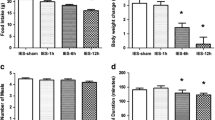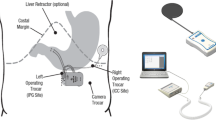Abstract
Background
Gastric electrical stimulation (GES) has recently been introduced as a potential therapy for the treatment of obesity. The main challenge for the new generation of devices is to achieve desired clinical outcomes at a suitably low level of energy consumption. The aim of this study is to compare the effectiveness of GES with continuous and intermittent duty cycles in reducing food intake and body weight in diet-induced obesity-prone rats.
Methods
In macro duty cycle experiment, 40 rats were divided into groups to receive a sham GES, continuous GES, or intermittent GES (15 min On–45 min Off or 15 min On–15 min Off) for 28 days. In micro duty cycle experiment, 18 rats received cross-over treatment of continuous stimulation, 60 % time cycle or 40 % time cycle. Food intake, body weight, gastric emptying and ghrelin level were measured to evaluate the effect of different GES.
Results
GES with macro duty cycle intensity-dependently reduced mean daily food intake increase by 18.6, 10.2 and -6.0 % compared to 42.7 % with sham GES and body weight gain by 6.1 %, 3.4 and -0.8 % compared to 5 % with sham GES. Daily food intake decreased with increasing micro duty cycle intensity, averaging 16.5, 15.6 and 13.7 g/day under 40 % cycle, 60 % cycle and continuous stimulation respectively. Gastric emptying was intensity-dependently delayed by GES. GES has no effect in modulating plasma ghrelin level.
Conclusions
GES energy-dependently reduces food intake, body weight and gastric emptying. Peripheral modulation of plasma ghrelin level is not related to the GES effects.




Similar content being viewed by others
References
Park MI, Camilleri M. Gastric motor and sensory functions in obesity. Obes Res. 2005;13:491–500.
Bray GA, Greenway FL. Current and potential drugs for treatment of obesity. Endocr Rev. 1999;20:805–75.
Basdevant A, Laville M, Ziegler O. Recommendations for the diagnosis, the prevention and the treatment of obesity. Diabetes Metab. 2002;28:146–50.
Bray GA, Ryan DH. Drug treatment of the overweight patient. Gastroenterology. 2007;132:2239–52.
Crookes PF. Surgical treatment of morbid obesity. Annu Rev Med. 2006;57:243–64.
Sagar PM. Surgical treatment of morbid obesity. Br J Surg. 1995;82:732–9.
Cigaina V. Gastric pacing as therapy for morbid obesity: preliminary results. Obes Surg. 2002;12 Suppl 1:12S–6S.
Cigaina VV, Saggioro A, Rigo VV, Pinato G, Ischai S. Long-term effects of gastric pacing to reduce feed intake in swine. Obes Surg. 1996;6:250–3.
Favretti F, De Luca M, Segato G, et al. Treatment of morbid obesity with the Transcend Implantable Gastric Stimulator (IGS): a prospective survey. Obes Surg. 2004;14:666–70.
Shikora SA. Implantable gastric stimulation for the treatment of severe obesity. Obes Surg. 2004;14:545–8.
Shikora SA, Bergenstal R, Bessler M, et al. Implantable gastric stimulation for the treatment of clinically severe obesity: results of the SHAPE trial. Surg Obes Relat Dis. 2009;5:31–7.
Shikora SA. "What are the Yanks doing?" the U.S. experience with implantable gastric stimulation (IGS) for the treatment of obesity—update on the ongoing clinical trials. Obes Surg. 2004;14 Suppl 1:S40–8.
Greenstein RJ, Belachew M. Implantable gastric stimulation (IGS) as therapy for human morbid obesity: report from the 2001 IFSO symposium in Crete. Obes Surg. 2002;12 Suppl 1:3S–5S.
Ouyang H, Xing J, Chen JD. Tachygastria induced by gastric electrical stimulation is mediated via alpha- and beta-adrenergic pathway and inhibits antral motility in dogs. Neurogastroenterol Motil. 2005;17:846–53.
Yin J, Chen JD. Retrograde gastric electrical stimulation reduces food intake and weight in obese rats. Obes Res. 2005;13:1580–7.
Zhang J, Tang M, Chen JD. Gastric electrical stimulation for obesity: the need for a new device using wider pulses. Obesity (Silver Spring). 2009;17:474–80.
Du P, Li S, O'Grady G, Cheng LK, Pullan AJ, Chen JD. Effects of electrical stimulation on isolated rodent gastric smooth muscle cells evaluated via a joint computational simulation and experimental approach. Am J Physiol Gastrointest Liver Physiol. 2009;297:G672–80.
Cummings DE, Purnell JQ, Frayo RS, Schmidova K, Wisse BE, Weigle DS. A preprandial rise in plasma ghrelin levels suggests a role in meal initiation in humans. Diabetes. 2001;50:1714–9.
Liu S, Tang M, Tao S, Chen JD. Central expressions of ghrelin and cholecystokinin in rats with gastric electrical stimulation. Obes Surg. 2008;18:109–14.
Xu J, McNearney TA, Chen JD. Gastric/intestinal electrical stimulation modulates appetite regulatory peptide hormones in the stomach and duodenum in rats. Obes Surg. 2007;17:406–13.
Tosetti C, Corinaldesi R, Stanghellini V, et al. Gastric emptying of solids in morbid obesity. Int J Obes Relat Metab Disord. 1996;20:200–5.
Wright RA, Krinsky S, Fleeman C, Trujillo J, Teague E. Gastric emptying and obesity. Gastroenterology. 1983;84:747–51.
Zahorska-Markiewicz B, Jonderko K, Lelek A, Skrzypek D. Gastric emptying in obesity. Hum Nutr Clin Nutr. 1986;40:309–13.
Dourmashkin JT, Chang GQ, Hill JO, Gayles EC, Fried SK, Leibowitz SF. Model for predicting and phenotyping at normal weight the long-term propensity for obesity in Sprague–Dawley rats. Physiol Behav. 2006;87:666–78.
Zhang J, Maude-Griffin R, Zhu H, et al. Gastric electrical stimulation parameter dependently alters ventral medial hypothalamic activity and feeding in obese rats. Am J Physiol Gastrointest Liver Physiol. 2011;301:G912–8.
Iwa M, Nakade Y, Pappas TN, Takahashi T. Electroacupuncture elicits dual effects: stimulation of delayed gastric emptying and inhibition of accelerated colonic transit induced by restraint stress in rats. Dig Dis Sci. 2006;51:1493–500.
Duggan JP, Booth DA. Obesity, overeating, and rapid gastric emptying in rats with ventromedial hypothalamic lesions. Science. 1986;231:609–11.
Sarnelli G, Caenepeel P, Geypens B, Janssens J, Tack J. Symptoms associated with impaired gastric emptying of solids and liquids in functional dyspepsia. Am J Gastroenterol. 2003;98:783–8.
Barkin JS, Reiner DK, Goldberg RI, Phillips RS, Janowitz WR. The effects of morbid obesity and the Garren–Edwards gastric bubble on solid phase gastric emptying. Am J Gastroenterol. 1988;83:1364–7.
Horowitz M, Collins PJ, Shearman DJ. Effect of increasing the caloric/osmotic content of the liquid component of a mixed solid and liquid meal on gastric emptying in obese subjects. Hum Nutr Clin Nutr. 1986;40:51–6.
Sanmiguel CP, Haddad W, Aviv R, et al. The TANTALUS system for obesity: effect on gastric emptying of solids and ghrelin plasma levels. Obes Surg. 2007;17:1503–9.
Zhang J, Xu X, Chen JD. Chronic tachygastrial electrical stimulation reduces food intake in dogs. Obesity (Silver Spring). 2007;15:330–9.
Zhu H, Sallam H, Chen DD, Chen JD. Therapeutic potential of synchronized gastric electrical stimulation for gastroparesis: enhanced gastric motility in dogs. Am J Physiol Regul Integr Comp Physiol. 2007;293:R1875–81.
Kojima M, Hosoda H, Date Y, Nakazato M, Matsuo H, Kangawa K. Ghrelin is a growth-hormone-releasing acylated peptide from stomach. Nature. 1999;402:656–60.
Inui A, Asakawa A, Bowers CY, et al. Ghrelin, appetite, and gastric motility: the emerging role of the stomach as an endocrine organ. FASEB J. 2004;18:439–56.
Ejskjaer N, Vestergaard ET, Hellstrom PM, et al. Ghrelin receptor agonist (TZP-101) accelerates gastric emptying in adults with diabetes and symptomatic gastroparesis. Aliment Pharmacol Ther. 2009;29:1179–87.
Murray CD, Martin NM, Patterson M, et al. Ghrelin enhances gastric emptying in diabetic gastroparesis: a double blind, placebo controlled, crossover study. Gut. 2005;54:1693–8.
Asakawa A, Inui A, Kaga T, et al. Ghrelin is an appetite-stimulatory signal from stomach with structural resemblance to motilin. Gastroenterology. 2001;120:337–45.
Abell T, McCallum R, Hocking M, et al. Gastric electrical stimulation for medically refractory gastroparesis. Gastroenterology. 2003;125:421–8.
Gallas S, Sinno MH, Boukhettala N, et al. Gastric electrical stimulation increases ghrelin production and inhibits catecholaminergic brainstem neurons in rats. Eur J Neurosci. 2011;33:276–84.
Zhang J, Liu S, Tang M, Chen JD. Optimal locations and parameters of gastric electrical stimulation in altering ghrelin and oxytocin in the hypothalamus of rats. Neurosci Res. 2008;62:262–9.
Tang M, Zhang J, Chen JD. Central mechanisms of gastric electrical stimulation involving neurons in the paraventricular nucleus of the hypothalamus in rats. Obes Surg. 2006;16:344–52.
Disclosures
This study was funded by Medtronic to J Chen. Medtronic employees (R. Maude-Griffin, and W. Starkebaum) participated in the study design, analysis, and manuscript preparation.
Author information
Authors and Affiliations
Corresponding author
Additional information
Shiying Li and Roland Maude-Griffin contributed equally to this paper.
Rights and permissions
About this article
Cite this article
Li, S., Maude-Griffin, R., Sun, Y. et al. Food Intake and Body Weight Responses to Intermittent vs. Continuous Gastric Electrical Stimulation in Diet-Induced Obese Rats. OBES SURG 23, 71–79 (2013). https://doi.org/10.1007/s11695-012-0773-2
Published:
Issue Date:
DOI: https://doi.org/10.1007/s11695-012-0773-2




